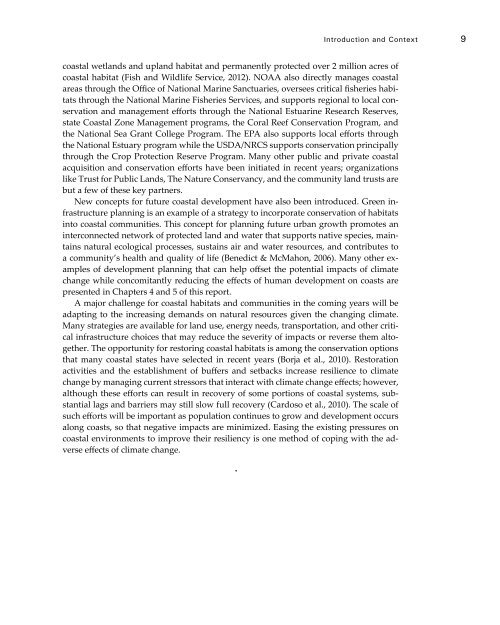Coastal Impacts, Adaptation, and Vulnerabilities - Climate ...
Coastal Impacts, Adaptation, and Vulnerabilities - Climate ...
Coastal Impacts, Adaptation, and Vulnerabilities - Climate ...
You also want an ePaper? Increase the reach of your titles
YUMPU automatically turns print PDFs into web optimized ePapers that Google loves.
Introduction <strong>and</strong> Context 9coastal wetl<strong>and</strong>s <strong>and</strong> upl<strong>and</strong> habitat <strong>and</strong> permanently protected over 2 million acres ofcoastal habitat (Fish <strong>and</strong> Wildlife Service, 2012). NOAA also directly manages coastalareas through the Office of National Marine Sanctuaries, oversees critical fisheries habitatsthrough the National Marine Fisheries Services, <strong>and</strong> supports regional to local conservation<strong>and</strong> management efforts through the National Estuarine Research Reserves,state <strong>Coastal</strong> Zone Management programs, the Coral Reef Conservation Program, <strong>and</strong>the National Sea Grant College Program. The EPA also supports local efforts throughthe National Estuary program while the USDA/NRCS supports conservation principallythrough the Crop Protection Reserve Program. Many other public <strong>and</strong> private coastalacquisition <strong>and</strong> conservation efforts have been initiated in recent years; organizationslike Trust for Public L<strong>and</strong>s, The Nature Conservancy, <strong>and</strong> the community l<strong>and</strong> trusts arebut a few of these key partners.New concepts for future coastal development have also been introduced. Green infrastructureplanning is an example of a strategy to incorporate conservation of habitatsinto coastal communities. This concept for planning future urban growth promotes aninterconnected network of protected l<strong>and</strong> <strong>and</strong> water that supports native species, maintainsnatural ecological processes, sustains air <strong>and</strong> water resources, <strong>and</strong> contributes toa community’s health <strong>and</strong> quality of life (Benedict & McMahon, 2006). Many other examplesof development planning that can help offset the potential impacts of climatechange while concomitantly reducing the effects of human development on coasts arepresented in Chapters 4 <strong>and</strong> 5 of this report.A major challenge for coastal habitats <strong>and</strong> communities in the coming years will beadapting to the increasing dem<strong>and</strong>s on natural resources given the changing climate.Many strategies are available for l<strong>and</strong> use, energy needs, transportation, <strong>and</strong> other criticalinfrastructure choices that may reduce the severity of impacts or reverse them altogether.The opportunity for restoring coastal habitats is among the conservation optionsthat many coastal states have selected in recent years (Borja et al., 2010). Restorationactivities <strong>and</strong> the establishment of buffers <strong>and</strong> setbacks increase resilience to climatechange by managing current stressors that interact with climate change effects; however,although these efforts can result in recovery of some portions of coastal systems, substantiallags <strong>and</strong> barriers may still slow full recovery (Cardoso et al., 2010). The scale ofsuch efforts will be important as population continues to grow <strong>and</strong> development occursalong coasts, so that negative impacts are minimized. Easing the existing pressures oncoastal environments to improve their resiliency is one method of coping with the adverseeffects of climate change.
















